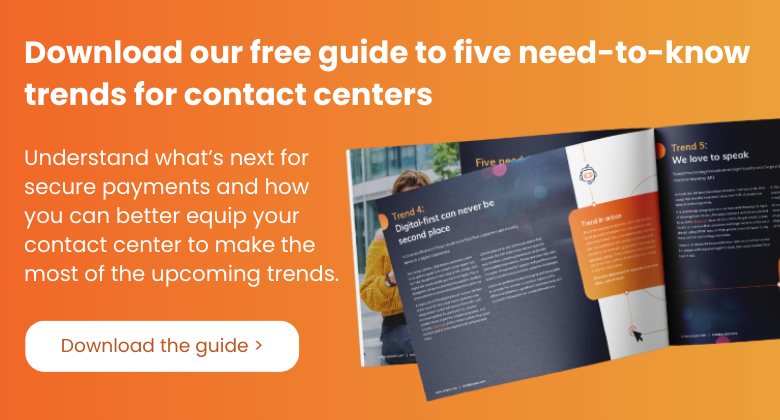Bringing commerce to people—instead of people to commerce—is the key USP of Pay by Link.
For consumers, Pay by Link payments offer a convenient and secure way to pay for goods and services without having to give their payment details to an agent or key long card numbers into their phone.
For all the ease that Pay by Link offers, contact centers shouldn’t sacrifice the customer experience by opting to send the link and then forget. It’s important to give the customer the option to be guided by the contact center agent through the Pay by Link process.
What is Pay by Link?
Pay by Link (sometimes known as request to pay) gives contact centers the ability to automatically generate a unique payment link for their customers. The payment link can be shared directly by email, SMS, WhatsApp, direct messaging on social media, or by agents during live chat or phone, for example.
Pay by Link offers customized payment pages and unique reference codes, making it easy for customers to simply confirm the amount they want to pay. The items and quantities are pre-selected, and details like shipping costs are already sorted before the customer reaches the payment stage. After the customer’s device shares their information through the payment link, they’ll receive real-time confirmation that the payment has been successful.
Pay by Link is being used around the world by various businesses, big and small. A big part of its adoption is due to the ability to pay effortlessly with eWallets such as Venmo, Google Pay and Apple Pay, the latter having more than 500 million users worldwide.
The issue with ‘send and forget’
Digital payment links can reduce the manual effort and administrative overheads by leaving the customer to complete the transaction unaided—effectively sending a payment link and then forgetting about it.
This ‘send and forget’ approach comes with several disadvantages:
- Payment delays — without reminders or follow-up actions, customers may not feel a sense of urgency to pay immediately—or at all—slowing down cash flow for the business.
- Loss of customer interaction — customers lose the personal touch of a follow-up reminder, for example, and businesses are left in the dark if customers encounter payment problems.
- Loss of links — links can go astray due to inadvertent deletion or expiration, leading to frustration, late payments or abandonment, and need for manual intervention.
- Trust issues — without support and communication from the business, customers may have security concerns about the safety of paying by a link.
Why a guided Pay by Link process matters
A guided Pay by Link process, on the other hand, can significantly enhance the customer experience:
- More clarity and confidence — for those customers who are less tech-savvy or unfamiliar with online payment methods, receiving clear pre-payment instructions on how to proceed with the payment is especially useful.
- Reduced payment abandonment — real-time support at every step alerts customers of any errors (such as inputting the wrong details) and decreases the chances of the customer abandoning the payment due to frustration or uncertainty.
- Improved perception of security — a well-designed, guided process can provide clear cues about cyber security, such as showing trusted payment gateways, encryption symbols or security certificates (such as PCI compliance). This will help to reassure any customers who are concerned about online fraud and phishing.
- Personalization — it’s also possible to personalize the guided experience by customer profile, showing the consumer tailored payment options, their preferred methods or their language preferences.
- Real-time communication — guided processes often provide status updates and post-payment confirmation, letting the customer know when the payment has been received.
In conclusion
The rising popularity of Pay by Link is part of a broader shift away from cash and toward digital and mobile payments, thanks greatly to the widespread adoption of eWallets. At the same time, customer experience cannot be underestimated or neglected.
Taking the ‘send and forget’ approach, whilst efficient, invites risk of customer frustration and payment delay. It also forgoes the lucrative opportunity for brand connection that could motivate loyalty and future purchases.
Conversely, a guided Pay by Link process helps customers by making the payment experience clearer, more secure and more convenient, thereby increasing the likelihood of successful transactions and fostering invaluable customer satisfaction.













